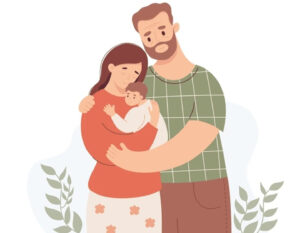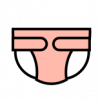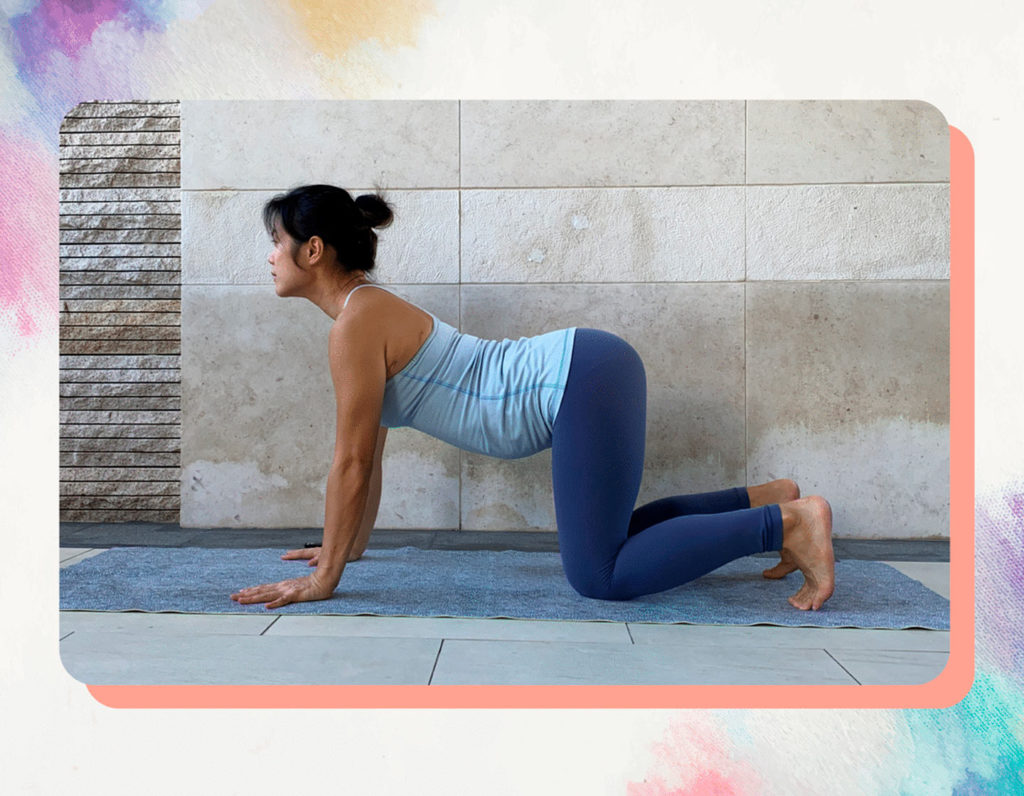
Mamaste!
As a prenatal yoga teacher, I often get asked by my pregnant students which prenatal yoga poses that they can safely do at home – because, let’s face it, as much as we all aspire to attend a prenatal yoga class every day and spend an hour stretching our way into bliss, not everyone has the time and resources to enjoy this luxury. With recent pandemic events thrown into the mix, why not explore some easy, beginner-friendly yoga poses suitable for each trimester at home instead.
The body goes through big and exciting transformations throughout the whole pregnancy journey, bringing about physical discomforts and emotional shifts. Yoga can help expectant mamas relieve such discomforts, build self-awareness to prepare the body and mind for childbirth, and also relieve stress so you feel more relaxed and confident about your pregnancy and birth. With that in mind, let’s explore these seven safe yoga poses to practise for your first trimester. The first in a three-part series, we’ve got you covered, Mama, for the second and third trimester as well.
Editor’s note: This article contains information and instruction about Yoga and Health. The information contained herein is intended for educational purposes only, and should not be substituted for medical advice from a doctor or healthcare provider. You must consult your doctor or healthcare provider before embarking on this or any other exercise program. Special cautions may apply to individuals with specific health issues therefore you should consult your doctor or healthcare provider to find out if special restrictions apply to you. Not all exercises are suitable for everyone and this or any exercise program may result in injury. To reduce the risk of injury, never force or strain during exercise. If you experience pain, discomfort or feel light-headed during exercises, stop immediately and consult your doctor or healthcare provider.
Read more: What Kind Of Yoga In Hong Kong Is Right For You?
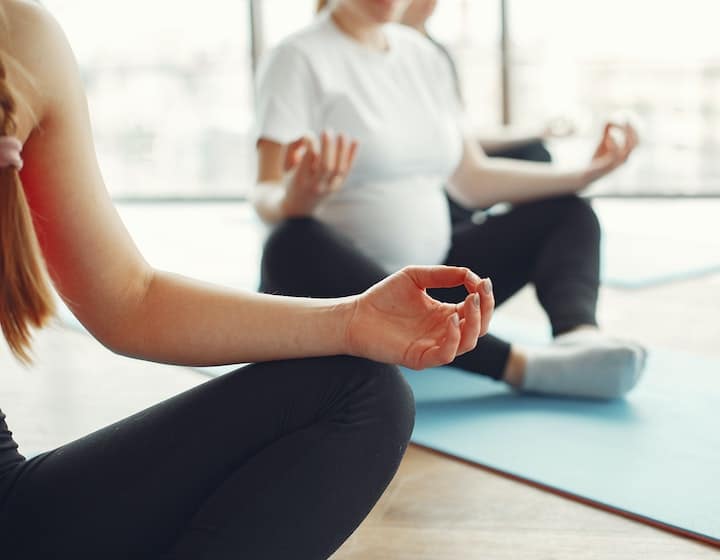
Prenatal Yoga And Your Pregnancy
The prenatal yoga asanas (poses) mentioned below are suitable for all experience levels, however, it is important to note that every pregnancy is different and the same pose can be experienced very differently from individual to individual. Listen to your body and your intuition, and let them guide you through your practice. Even if you are an experienced practitioner, it’s perfectly normal and expected that your body does not respond in the same way to the poses as it would before you got pregnant – please let go of the expectations that you have to keep your yoga practice at the same intensity and level.
Remember, you are creating a beautiful life inside of you and that takes priority over achieving the “perfect” yoga pose! My job as a yoga teacher is to provide the tools (i.e. the poses) to help you feel better physically and emotionally, but it’s your job to tune in to yourself and never push yourself to do something that doesn’t feel right. Whilst in the yoga poses, you should not be straining or holding your breath in any way. Let the breath flow easily and naturally to ensure there is enough oxygen supply to yourself and your baby!
To practise these yoga poses, you will need:
- A yoga mat or a non-slippery surface
- One or two yoga blocks. If you don’t any blocks on hand, you may substitute with a firm pillow (for sitting on), a thick book or anything stable (for placing the hands on/supporting or elevating the body), rolled up towels (for supporting the knees)
- A yoga bolster. You may not need this, but if you find that you need the support and don’t have a bolster, use some cushions and tightly rolled-up towels/blankets to substitute
- A yoga strap. This can be easily substituted with a belt or long towel
Pregnancy is a time to respect and honour your amazing body, however it may be feeling. Allow your own intuition to guide you and inform you about what to do in your yoga practice, the same way you would let it guide you in making informed decisions throughout your pregnancy and birthing process.
Read more: Pregnancy Nutrition: Where To Get Prenatal Vitamins In Hong Kong
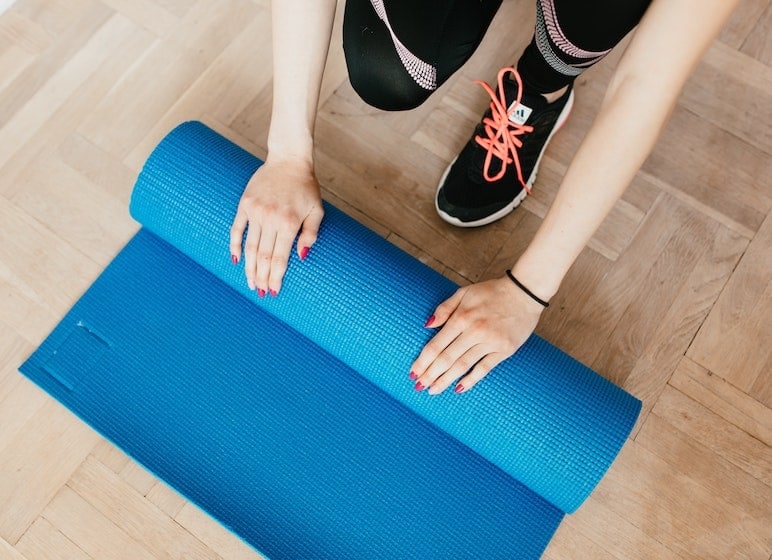
Safe Prenatal Yoga Poses For The First Trimester (weeks 1-13)
Oh, the joys of the first trimester! You may have just found out you’re pregnant (congrats!) and feeling excited and overjoyed one minute, then nervous and anxious the next. From the moment of conception, pregnancy hormones are raging through your body, which may result in mood fluctuations. Your belly may not be showing yet, but dramatic developments are occurring inside. Your body is working extremely hard to grow a little person, and this may bring on discomforts such as fatigue, nausea/vomiting, change in appetite, heartburn, tender or swollen breasts, frequent urination, constipation, abdominal bloating and cramping (ah, the joys!). It’s best to keep practice gentle and restorative to honour the taxing demands on your body during this time. The first trimester is a time to slow down, focus inwards, and create a nice, cosy environment for the baby to grow.
Personally, I have found breathing exercises very helpful not only for coping with nausea and anxiety during the first trimester, but also staying calm and focused throughout the whole pregnancy and labour process. The pranayama exercises that I like to practise and teach are:
- Sama Vritti (Equal Breathing – counting the inhales and exhales, making them equally long, no breath retention!)
- Golden Thread Breath (inhale through the nose, exhale through mouth like blowing a candle softly and slowly), Dirgha Pranayama (Yogic Three-Part Breath)
- And Nadi Shodhana (alternate nostril breathing).
If you are unfamiliar with these pranayama or breathing techniques, please practise them under the guidance of an experienced yoga teacher. As for the prenatal yoga poses, let’s get started!
 Child’s Pose (Balasana)
Child’s Pose (Balasana)
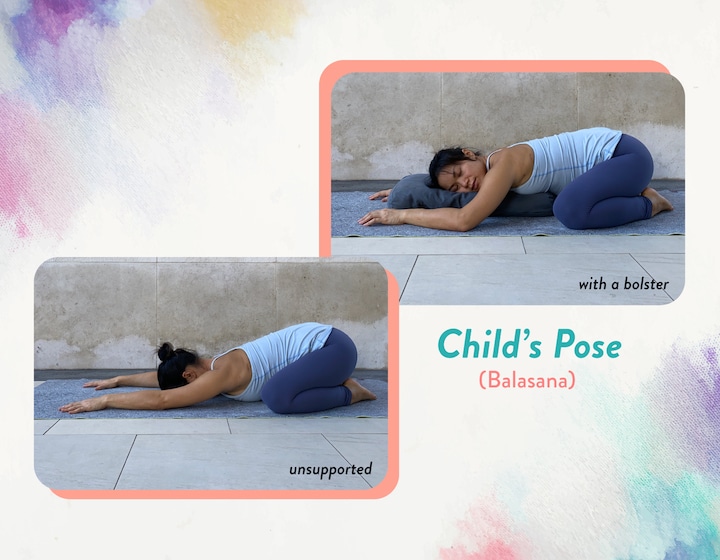
- Child’s Pose is a resting pose that allows you to lengthen the spine and stretch the back muscles. It’s a deeply restorative pose that helps alleviate stress and anxiety.
- Practising Child’s Pose with the knees apart helps to open the hips and stretch the inner thighs. It also makes room for the belly to avoid compressing it.
- If you feel discomfort in the knees, try placing a folded blanket behind your knees or place a bolster over the heels so you can sink the hips down onto the bolster.
- For a more supported version of Child’s Pose, you may choose to place a bolster under the chest and head. This is a very calming position and one you can practise into the later stages of pregnancy.
How to do the Child’s pose:
- Start on your hands and knees. With the knees wide and big toes together, bring your hips back towards your heels. Stretch your arms out in front of you and rest your forehead on the mat; alternatively, for a more supported version, rest your chest and face on a bolster (turn your face to one side and do both sides).
- I would recommend staying for at least 5 breaths, but you’re welcome to stay as long as you feel comfortable.
 Cat/Cow (Marjaryasana/Bitilasana)
Cat/Cow (Marjaryasana/Bitilasana)
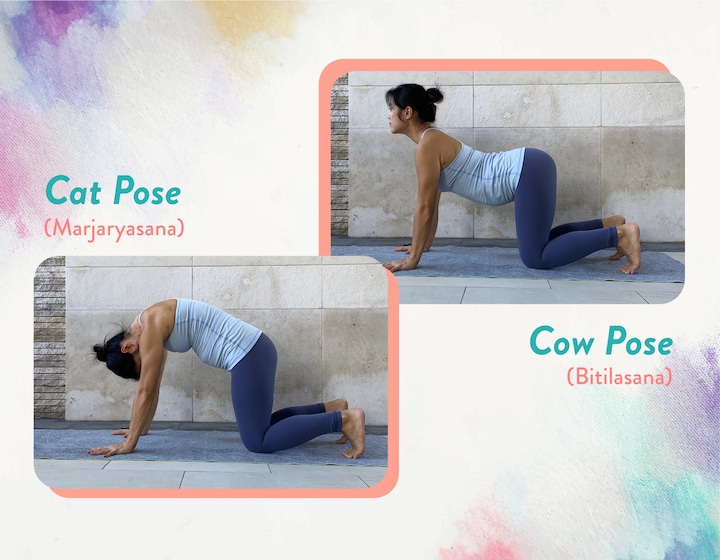
- When it comes to prenatal yoga poses, many mamas in their first trimester would be happy to do Cat/Cows all day long and nothing else! Cat and Cow are my go-to poses for stretching the spine and relieving pressure on the lower back. They are also good for loosening up the muscles around the pelvis.
- If the wrists are sore, lower your forearms onto blocks or curl your hands into fists and press the fists down on the mat instead of having the palms flat.
- If the knees hurt, cushion them by sliding a rolled-up towel underneath.
- Take a more neutral position if the full range of Cat and Cow causes discomfort on the back – i.e. don’t drop the belly as much or over-round the spine.
How to do the Cat/Cow pose:
- Come down onto your hands and knees. Inhale, lengthen and arch the spine into Cow Pose, looking forwards.
- Exhale, round the spine into Cat Pose, looking towards the belly.
- Repeat steps 1 and 2 as you move with the breath for as long as you like.
- Feel free to circle the hips and shoulders as you move through your Cat/Cows.
Read more: Where To Get Women’s And Family Health Checks In Hong Kong
 Puppy Pose, a.k.a Half Downward Dog (Anahatasana)
Puppy Pose, a.k.a Half Downward Dog (Anahatasana)
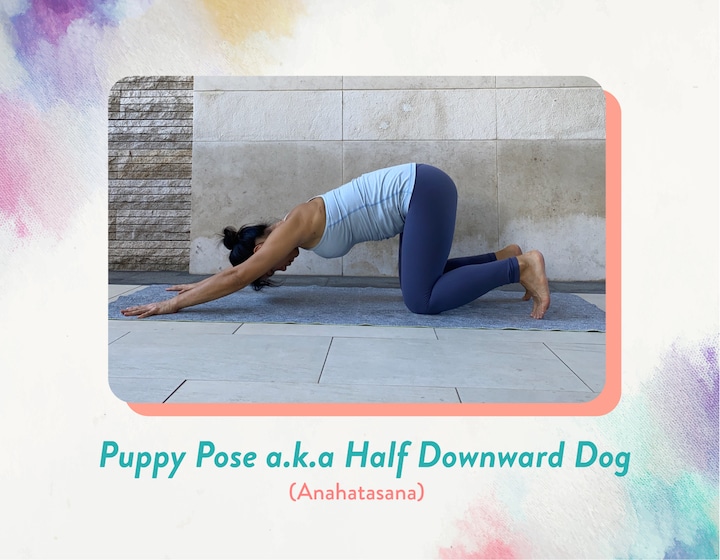
- This is a great prenatal yoga alternative to the full Downward Dog pose, especially for moms who are feeling nauseous (when it doesn’t feel good to practise inverted poses with the head below the heart). You will still benefit from the spinal lengthening and shoulder opening without lifting the knees and hips up to a full Downward Dog.
- At any time during pregnancy, the Puppy Pose is a preparatory pose and alternative to Downward Dog.
- In later stages of pregnancy, it works to promote optimal foetal positioning.
How to do Puppy/Half Downward Dog:
- From all fours, keeping the hips on top of the knees, walk your hands forward until your arms are extended straight out towards the front of the mat.
- Spread your fingers, press the mat away with the hands, and reach the sitting bones back to lengthen the spine.
- If it feels good, lower your forehead down to the mat or onto a block.
 Sphinx or Cobra Pose (Salamba Bhujangasana/Bhujangasana)
Sphinx or Cobra Pose (Salamba Bhujangasana/Bhujangasana)
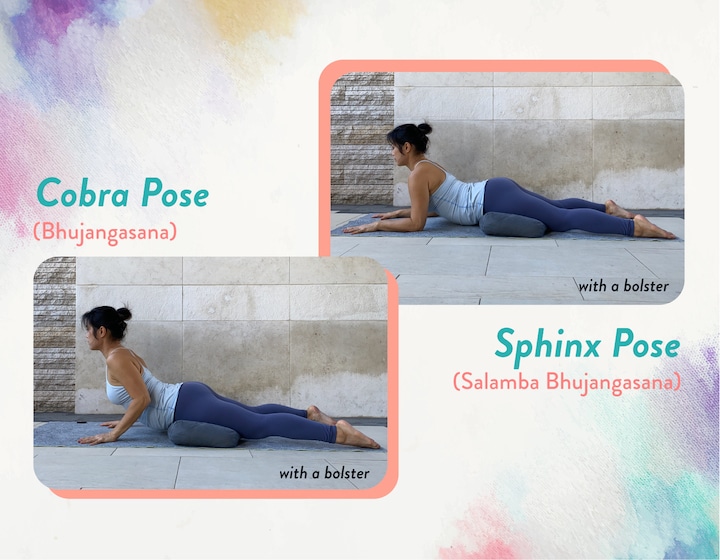
- This gentle backbend can help stimulate circulation, which may help moms feel more energized in the first trimester when lethargy is very common.
- In general, backbends strengthen back muscles and stretch the front of the body including the chest, shoulders and abdomen.
- You can choose to do Sphinx Pose or Cobra Pose depending on how each pose feels on your body, but if you feel this might be a stretch too far you can find another pose that you’re more comfortable with.
- If your bump is getting a bit bigger but doesn’t feel squished, you may rest your abdomen and pelvis on the mat without any support. However, if your bump is bigger or if you feel bloated, it’s nice to have a bolster under the pelvis as shown in the picture.
How to do the Sphinx pose:
- Lying on the front body (with or without bolster under the pelvis) with legs apart, place your forearms on the mat and lift your chest with an inhalation. Stay for 3-5 breaths. Release back onto the mat with an exhalation.
How to do the Cobra pose:
- Lying on the front body (with or without bolster under the pelvis) with legs apart, spread the hands on the mat under the shoulders and press down to lift your chest with an inhalation. Stay for 3-5 breaths. Release back onto the mat with an exhalation.
 Bridge or Supported Bridge (Setu Bandha Sarvangasana)
Bridge or Supported Bridge (Setu Bandha Sarvangasana)
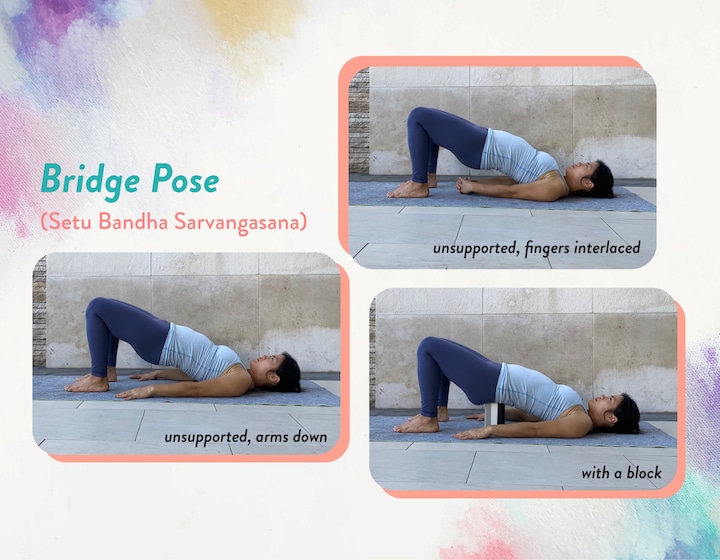
- Bridge Pose is a backbend that strengthens the back muscles, buttocks and legs while stretching the chest, shoulders, front of the torso and thighs.
- For a more restorative version, take Supported Bridge by placing a block under the sacrum (the lower back).
- Practising either of these poses may assist digestion, calm the mind and alleviate stress.
How to do the Bridge pose:
- Start by lying on your back, knees bent and feet apart. With the inhale, press into the feet and lift your hips and mid-back off the mat, lifting up to a comfortable height without overly compressing the lower back.
- Arms can stay alongside the body, or you can choose to interlace your fingers behind the back, walking the outer shoulders in to open up the chest.
- Breathe freely as you stay in Bridge Pose. Stay for 3-5 breaths, then with an exhalation, lower one vertebra at a time until the tailbone comes down last.
Sassy Mama tip: If you would like to take Supported Bridge, after lifting the hips up, slide a block under the sacrum – the block can be on any height that feels right. Allow the block to support the pelvis. Stay for 1 minute or longer if you enjoy the pose. After exiting a longer-held Supported Bridge pose, I like to widen my feet to mat width distance and rest my knees against each other in a constructive resting pose.
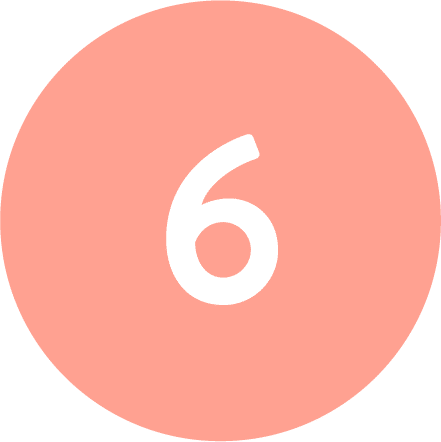 Supported Forward Bend (Paschimottanasana)
Supported Forward Bend (Paschimottanasana)
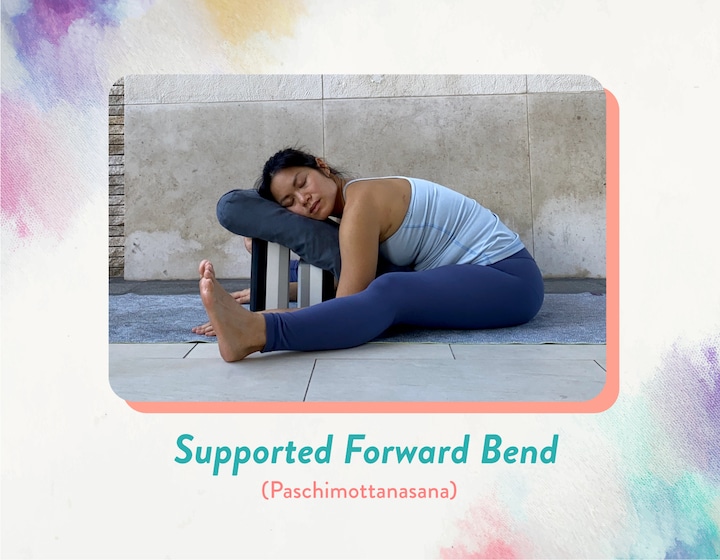
- Supported forward bends have a calming and grounding effect on the nervous system, allowing the body to be supported as our awareness is turned inwards. They are also said to improve digestion and reduce fatigue.
- This forward bend provides a gentle stretch along the spine and the back of the legs.
- Depending on how much space and flexibility you have, you may need some blocks, a bolster or a combination of props to support the upper body. You can also use the support of a chair at home.
How to do a Supported Forward Bend:
- Extend both legs out, widening the feet to make room for your belly as well as the props. Inhale, find length in the spine, then exhale, hinge forward from the pelvis while maintaining length in the lower back. Rest your upper body (including your head) on the props – you should be so supported that it doesn’t require any effort to stay in the pose. Relax your arms and allow your upper body to soften with every exhale. You may want to turn your head to one side (remember to switch sides halfway through the pose!) or rest your forehead on the props.
- If using a chair, you can rest your forehead on the chair or on stacked palms.
- Breathing naturally in and out the nose, stay for as long as it is comfortable to you.
- To come out of the pose, keep the upper body relaxed and use your hands to walk yourself up to a seated position. Spend a few moments in stillness sitting up and notice the effects of the forward fold on your body and mind.
 Bound Angle Pose, a.k.a. Butterfly Pose (Baddha Konasana)
Bound Angle Pose, a.k.a. Butterfly Pose (Baddha Konasana)
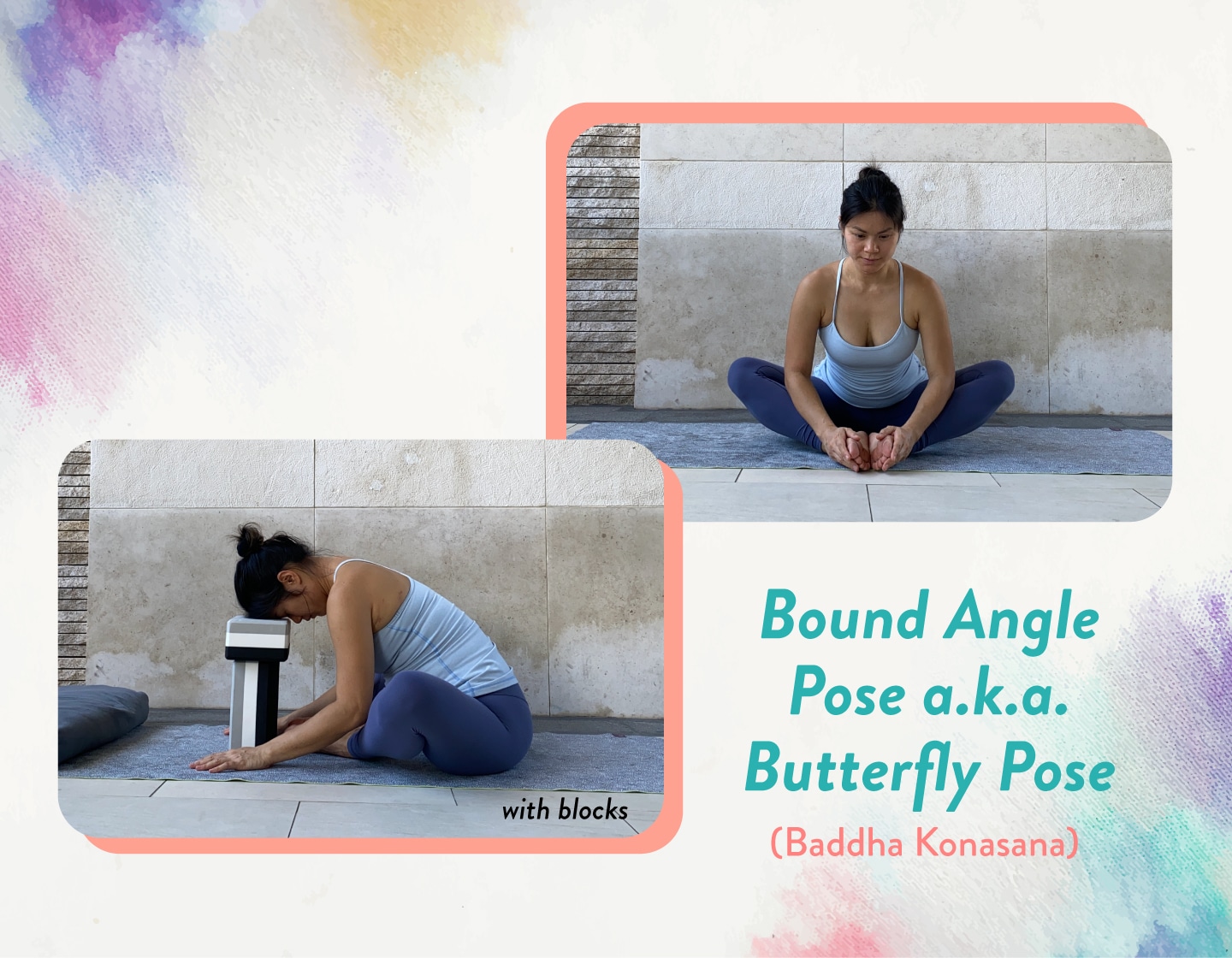
- This pose opens up the hips and stretches the muscles of the groin. You may also find a nice stretch in the back as you fold forward.
- You may choose to take an unsupported version of the pose or a supported one with props. A supported pose would be more restorative and grounding.
How to do the Bound Angle pose:
- From sitting, bring the soles of the feet together and draw them in towards your groin. Inhale, lengthen the spine, then exhale and fold forwards. You can allow the upper body to hang, relaxing the neck and shoulders, or choose to support the upper body with props (in the image, I’m supporting my forehead with two blocks, but feel free to use a combination of blocks and bolster/cushions to support yourself).
- If your hips feel stuck and you’re unable to fold forwards much, try sliding your feet away from the groins to form a wider diamond shape with the legs. This should allow more space for you to bend forwards. Alternatively, slide a folded blanket or a cushion under the hips to elevate the seat before folding forwards.
Be sure to enjoy your first trimester as much as you can with these yoga techniques. And be sure to keep a lookout for the next instalment – Safe Prenatal Yoga Poses For The Second Trimester.
Read more: Pre And Postnatal Fitness Part 1: Safe Exercise For The First Trimester
 View All
View All


 View All
View All
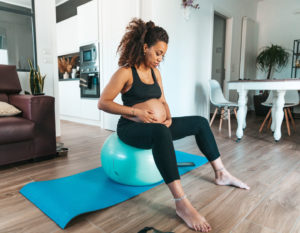
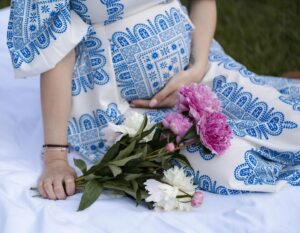
 View All
View All View All
View All
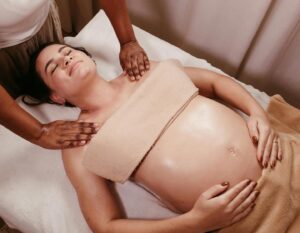

 View All
View All